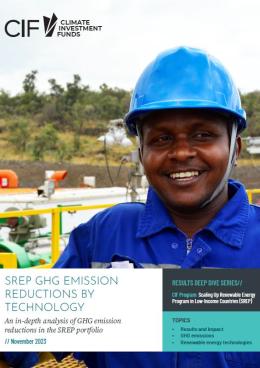SREP GHG emission reductions by technology
This Results Deep Dive focuses on expected greenhouse gas (GHG) emission reductions through the Scaling Up Renewable Energy Program in Low Income Countries (SREP) Program of the Climate Investment Funds (CIF).
SREP aims to enable the world’s poorest countries to foster transformational change a
...This Results Deep Dive focuses on expected greenhouse gas (GHG) emission reductions through the Scaling Up Renewable Energy Program in Low Income Countries (SREP) Program of the Climate Investment Funds (CIF).
SREP aims to enable the world’s poorest countries to foster transformational change and pursue low-carbon energy pathways. It seeks to increase overall energy access for the populations of partner countries; deliver economic uplift; and reduce reliance on fossil fuels. As a benefit of its interventions, it also aims to minimize GHG emissions. This Results Deep Dive examines the potential of GHG emission reductions of SREP funds by looking at annual expected emission reductions by technology and connection type in the current portfolio based on data for the reporting year 2023.
Providing access to clean, affordable energy is critical to mitigating climate change while also improving the lives of millions of people around the world. It therefore constitutes a vital part of CIF's mission, and the CIF has supported the extension of electricity access to almost two million people since its inception in 2009. SREP focuses on a group of largely low-income and lower-middle income countries, aiming to fill a persistent gap these developing countries face—a shortfall in financing for transitions to clean, renewable energy. In addition to directly supporting investments in clean energy and energy access, some SREP projects focus on strengthening the enabling environment to allow these investments to happen. SREP interventions support transitions to renewable energy, which play a key role in reducing GHG emissions and mitigating climate change at a global scale.





